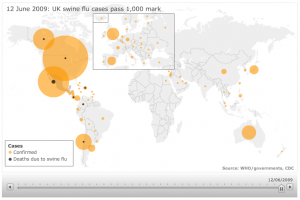Filed under: Social Media | Tags: Facebook, Google, Search, Trends | Comments Off on Social Relevancy – The Future of Contextual Search?
ReadWriteWeb has a good article on the upcoming battle for dominance in search between Google and social upstarts Facebook. For most of us Google’s position as the ‘go to’ site on the web for searching is an ongoing certainty, we even use the phrase ‘to Google’ to indicate that we’re doing a search. However there are two fronts on which industry commentators are concerned that the search giant’s dominance may start to be challenged – the first is real time search, and the second is social relevancy.
Twitter is the golden child of real-time search at the moment, with the bite-sized information posting rapidly lending itself to a global network of immediacy (and the usual increases in spam). Something posted on Twitter in the last few minutes is generally more relevant to a time based event than anything posted elsewhere on the web in the past, or in the next hour. Facebook has attempted to challenge Twitter’s fast rising star with it’s own interface re-tooling to use status updates in the same way, but status is ultimately a personal statement, whereas Twitter has left it very much to the user to decide what their Tweets are about. This search paradigm shift is ongoing, and will continue for a while.
Social relevancy is a much more concerning attack for Google. The basic principle is that when you want information you would normally trust your friends and contacts more than a random stranger on the web. Trust is a critical web commodity, one that is slow to lend and hard to build. Want to know the cool places to go out in your neighbourhood? Then you ask your friends and peers. Want to know how stars are formed? You ask Google. ReadWriteWeb express this as:
^
|
| Increasing
| Relevancy
| |
Friends and Following |
|
| Taste Neighbours |
| Friends of Friends |
| Influencers |
| The Crowd (Aggregate) |
Google sits firmly at the bottom of this hierarchy – processing the crowd and its network of links with complex rules to provide us with quick and (generall) accurate responses. Facebook and other social networks, from the first days of Six Degrees, sit with the top two positions. This positions are hard for Google to gain a foothold in as the time and effort necessary to get people on-board and to build up an accurate social graph are large, and although Google has the resources the question remains as to whether Google’s brand perception amongst people is sufficient to create a Facebook ‘killer’.
That’s not to mean Google isn’t trying to gain footholds into this market. They’ve supported open standards for creating semantic links describing relationships. They’ve bought out social networks of their own. They’ve even announced an advanced, in-browser UI (Google Wave) that lets you combine all your services in one place in real-time. Meanwhile Facebook still prevents Google and other search engines from spidering Facebook’s information and hence ascertaining a social graph of their own. Facebook want to own this space and won’t broker any deals that don’t help them reach this goal.
This is an interesting transition and it’s still hard to say who will win. Google ousted the search incumbents under 10 years ago, and there’s nothing to stop them being ousted in turn. Interesting times lie ahead for search and for us in the world of networked services.
Filed under: Interaction Design | Tags: Flash, Infographic | Comments Off on Swine Flu Dynamic Infographic
As cases of the, now pandemic, swine flu breach 1,000 in the UK, the BBC has run a great dynamic infographic to show the spread of cases globally.

The animation is run using the slider along the bottom, showing both the increase in cases of the flu and the related deaths – in the light and dark circles respectively. Thankfully at this time the death figures are still low, and we can only hope that the preparedness plans in place around the world will keep it that way, but still the BBC graphic is a wonderfully simple yet effective illustration.
Filed under: Graphic Design, Interaction Design, Internet Marketing | Tags: Design Tips, Reading List, Useful Link | Comments Off on Helpful Hints on Designing Websites to Sell Products
Smashing Magazine has an interesting article on the key points to consider when designing a website that has to sell a product. The suggestions range from the subliminal – putting pictures of happy people to welcome people in, through the theoretical – such as the Guttenburg principle of how our attention moves across and down a page, to the practical – always provide a next step for users to move to. Definately worth a read.
Filed under: Interaction Design, Technology | Tags: Ambient Feedback, Green Thinking, Interaction Design | No Comments »
A few years back an American company, Ambient Devices, came up with an idea. They thought to themselves that if people could see how much electricity they were using, they would know when they are using a lot of it and then decide to turn off a few hair dryers, etc to cut down. Hmm.. but how to let people see how much magical, invisible energy they are using? Surely we just can’t know these days because so many things just use electricity in a non-obvious way, such as being on standby!

Ambient Devices’s answer? The Energy Orb, a small sphere that sits someone in your house, and glows different colours depending on your energy consumption. Using a lot of juice? The orb glows red and you know to cut back. Even with all the lights off you may be surprised to see how much the sphere still indicates you’re using, and that is its genius – it takes an invisible, dynamic system and presents it to you in an easily accessible manner.
This is all a very clever and engaging use of modern technology. Bright colours. Saves money on your electricity bills, and consequently the environment. Now a few more companies have jumped on the band wagon, producing more functional devices that give you up to the second energy usage in a manner that’s easy to absorb without really having to look for it.
Ambient Feedback is a great concept, and one that’s close to my heart, but is it actually new? Not really, it’s just a necessary evolution as we move further from the physical world to the less visible world of the internet and micro-electronics. In the days of my youth we already had a feedback mechanism that told us we were using too much electricity.. it was called the electricity meter. We knew immediately how much energy was being used by how many precious 50 pence pieces were going into the slot, and how empty the 50p bowl next to the meter had gotten since we last topped it up. Simple, and very easy to understand!
Of course there were times when this mechanism failed as no 50 pence pieces could be found anywhere in the house in the middle of the night, so I’m certainly not suggesting we move away from the wonders of Direct Debit, but it’s worth remembering how these things used to naturally be represented to us in a way that we never appreciated at the time. Then this knowledge can be used to make better, more relevant and useful interfaces to solve problems in our modern lives.
Filed under: Graphic Design | Tags: Design, Geo-tagging, Stock Photography, Tagging | No Comments »

Birmingham City?
These days many companies use stock photography for their website and print needs rather than spend a small fortune on having their own, unique photos taken by a professional. This can save you a lot of money, and allows graphic designers to be more innovative and creative within their design brief using their skills and knowledge of stock photography resources to create the best solution. Everyone’s happy.
Except, of course, if you use the wrong stock photo. Perhaps your tag line reads “Buy red roses this Valentines†and the photo is of a daisy – a flower for sure, but not a red rose. Or perhaps you made the same mistake as Birmingham City Council, and spent £15,000 sending out a flier to your residents thanking them for their recycling efforts with a picture of the wrong Birmingham skyline. Hmm. It’s an easy mistake to make – do a search in your stock photo resource for ‘birmingham skyline‘, choose your favourite image, then make your flyer. Simple. Except of course if you know Birmingham in England, you’d know it’s not Birmingham, Alabama, USA. Admittedly they are similar, but not that similar.
Even without knowing which company Birmingham Council used to design this flier we can know that it’s not really their fault. It’s an easy mistake to make and surely someone at Birmingham Council should have checked the flier before it went out, perhaps noticing a lack of famous Brum landmarks like the Bullring building.

Birmingham’s distinctive Bullring centre – by Joseph Maestri
So how can we stop this happening? Well two key things; firstly – make sure that whoever is doing the work has a full, descriptive creative brief, perhaps with a few example images that you’ve found yourself to illustrate a concept or idea, and make people aware of pitfalls (perhaps Brum council’s brand guidelines can have a warning that says ‘watch out for Birmingham, Alabama!’. Secondly, review the final product carefully! It’s so easy to make a mistake unwittingly, from a last minute typo to a generic town skyline, so get someone who’s not been involved with the process to do a review as they will have fresh eyes. On that last point, remember that every time you make a change, however small, you have a new product that may have new mistakes in it – if in doubt, review it again.
In this particular case there could have been a third possible saviour – geo-tagging. In this situation if the photo search had been restricted to searches in the greater Birmingham area, UK, then the US skyline should never have shown up in the first place. A good stock photo search will potentially warn you of such ‘duplicates’ – asking you which Birmingham you mean before it presents results. In the case of using cheap stock photo engines you often pay for what you get, cheaper, potentially good photos, with less comprehensive editorial and tagging processes. Buyer beware!


